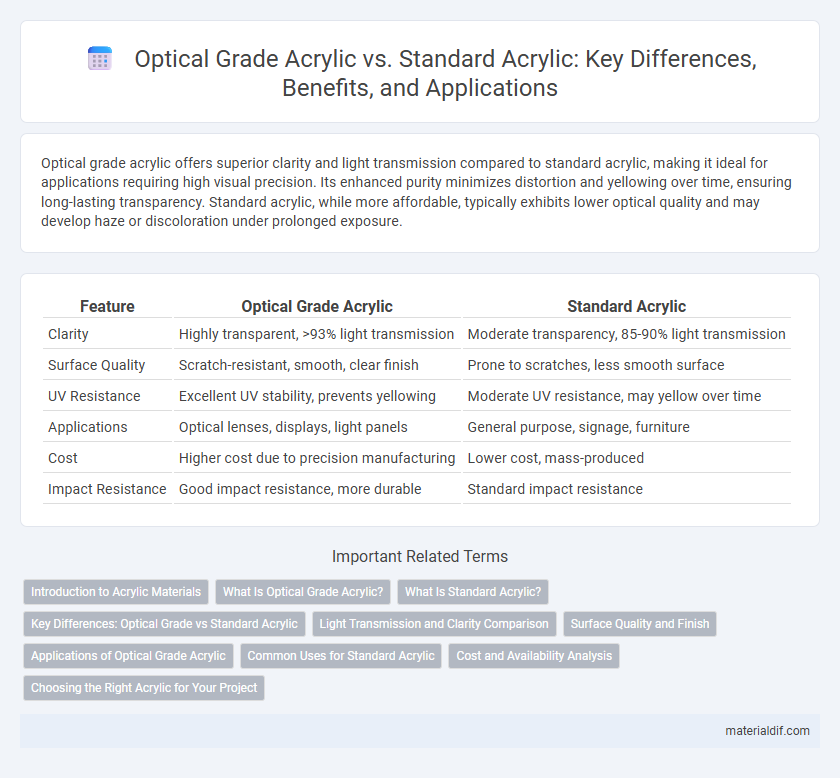Optical grade acrylic offers superior clarity and light transmission compared to standard acrylic, making it ideal for applications requiring high visual precision. Its enhanced purity minimizes distortion and yellowing over time, ensuring long-lasting transparency. Standard acrylic, while more affordable, typically exhibits lower optical quality and may develop haze or discoloration under prolonged exposure.
Table of Comparison
| Feature | Optical Grade Acrylic | Standard Acrylic |
|---|---|---|
| Clarity | Highly transparent, >93% light transmission | Moderate transparency, 85-90% light transmission |
| Surface Quality | Scratch-resistant, smooth, clear finish | Prone to scratches, less smooth surface |
| UV Resistance | Excellent UV stability, prevents yellowing | Moderate UV resistance, may yellow over time |
| Applications | Optical lenses, displays, light panels | General purpose, signage, furniture |
| Cost | Higher cost due to precision manufacturing | Lower cost, mass-produced |
| Impact Resistance | Good impact resistance, more durable | Standard impact resistance |
Introduction to Acrylic Materials
Optical grade acrylic features superior clarity and light transmission, making it ideal for applications requiring high transparency such as lenses and display screens. Standard acrylic offers durability and impact resistance but with less optical purity, suitable for general-purpose uses like signage and protective barriers. Both materials share the chemical composition of polymethyl methacrylate (PMMA), but manufacturing processes differentiate their optical and physical properties.
What Is Optical Grade Acrylic?
Optical grade acrylic is a high-purity, ultra-clear material designed for applications requiring superior light transmission and minimal distortion, commonly used in lenses, light guides, and display panels. Unlike standard acrylic, optical grade acrylic undergoes rigorous processing to eliminate impurities and internal stresses, ensuring exceptional optical clarity and consistent refractive index. This specialized acrylic enhances visual performance and durability in precision optical components.
What Is Standard Acrylic?
Standard acrylic is a versatile thermoplastic known for its clarity, durability, and affordability, commonly used in signage, displays, and protective barriers. It has good light transmission but may exhibit minor impurities or slight color tints compared to optical grade acrylic. Standard acrylic offers reliable mechanical strength and weather resistance, making it a popular choice for general applications where optical precision is not critical.
Key Differences: Optical Grade vs Standard Acrylic
Optical grade acrylic offers superior clarity with a light transmittance of approximately 92%, compared to standard acrylic's 88-90%, making it ideal for precision applications like lenses and displays. Its controlled refractive index and minimal impurities reduce distortion and improve light diffusion, whereas standard acrylic contains more inclusions leading to minor haziness. Optical grade acrylic also features enhanced UV resistance and consistent thickness, ensuring durability and uniform optical performance unmatched by standard acrylic sheets.
Light Transmission and Clarity Comparison
Optical grade acrylic offers superior light transmission rates, typically exceeding 92%, compared to standard acrylic's average of 85-90%, ensuring clearer and brighter visual clarity. Its enhanced purity and minimal internal stress reduce haze and distortion, making it ideal for applications demanding precise optical performance. Standard acrylic, while durable and versatile, often exhibits slight cloudiness and lower clarity, limiting its effectiveness in high-clarity requirements.
Surface Quality and Finish
Optical grade acrylic offers superior surface quality and finish compared to standard acrylic, characterized by its ultra-clear transparency and minimal distortion. The enhanced manufacturing process ensures a smooth, flawless surface with higher scratch resistance and optical clarity, making it ideal for lenses, displays, and precision instruments. Standard acrylic, while durable and versatile, typically exhibits slight imperfections and a less polished finish suited for general applications.
Applications of Optical Grade Acrylic
Optical grade acrylic delivers superior clarity, high light transmittance up to 92%, and minimal impurities, making it ideal for precision optical applications such as lenses, light guides, and display panels. Its exceptional surface quality and low birefringence ensure accurate light transmission and minimal distortion, essential for medical devices, scientific instruments, and high-end lighting fixtures. Compared to standard acrylic, optical grade acrylic provides enhanced durability and resistance to UV degradation, supporting long-term use in critical visual and optical systems.
Common Uses for Standard Acrylic
Standard acrylic is widely used in applications such as picture frames, signage, and display cases due to its cost-effectiveness and ease of fabrication. It offers good clarity and weather resistance, making it suitable for both indoor and outdoor projects where optical precision is not critical. Common uses also include protective barriers, retail shelves, and furniture components, where durability and aesthetic appeal are important.
Cost and Availability Analysis
Optical grade acrylic offers superior clarity and minimal light distortion, making it ideal for precision applications, but it generally costs 2 to 3 times more than standard acrylic due to its specialized manufacturing process. Standard acrylic is widely available and more affordable, commonly used in general-purpose projects where optical properties are less critical. The cost-effectiveness and broad availability of standard acrylic make it the preferred choice for budget-sensitive applications, while optical grade acrylic is reserved for situations demanding high visual performance.
Choosing the Right Acrylic for Your Project
Optical grade acrylic offers superior light transmission up to 92%, enhanced clarity, and minimal impurities, making it ideal for applications requiring precise optical performance like lenses and displays. Standard acrylic provides good durability and cost-effectiveness but contains more inclusions and lower light transmission, suitable for general use such as signage and protective barriers. Selecting the right acrylic depends on project requirements for clarity, light diffusion, and budget constraints to ensure optimal functionality and visual impact.
Optical Grade Acrylic vs Standard Acrylic Infographic

 materialdif.com
materialdif.com